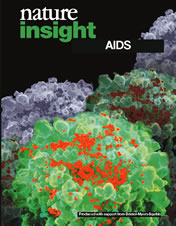AIDS
Vol.
410, No. 6831 (19 April 2001).
|![]() PDF
PDF![]() (266
(266![]() K)
K)![]() |
|
 |
| Cover
illustration Progeny HIV particles (red) emerging from an infected T lymphocyte (green) showing how many progeny can be generated in a single infected cell. (Image provided by D. Hockley/NIBSC/SPL.) |
The scale of the human immunodeficiency virus (HIV) epidemic is far greater than was predicted a decade ago. Already almost 20 million people have died of AIDS, over 30 million are currently living with HIV, and 16,000 new infections occur daily. It is clear that methods aimed at controlling the spread of the virus are failing to do so. Existing AIDS therapies are out of reach for most HIV-infected people in developing countries and, where available, they are limited by their toxicity and their cost. Furthermore, it is becoming increasingly apparent that current drugs are unable to purge the body of the virus and that discontinuation of triple therapy leads to a rapid rebound of plasma viraemia. Development of an effective HIV vaccine therefore remains one of the most pressing challenges facing modern medicine, and new types of drugs to treat already established disease are needed urgently.
In this month's Nature Insight we examine the
biology of the virus and the disease it causes. We begin with reviews focusing
on the current status of the AIDS global pandemic, covering the incidence and
patterns of infection, and the potential threat posed by the evolution of opportunistic
infections in a growing proportion of immunocompromised people. The following
two articles discuss the underlying causes for the progressive and relentless
depletion of CD4+ T cells, and for the inability of cytotoxic T cells
to control infection in the long term. We then focus on the molecular pathways
that give rise to neuronal injury and apoptosis in HIV-associated dementia, followed
by a comprehensive review of HIV chemotherapy. The final article reviews the scientific
challenges facing HIV vaccine development.
We hope that both general readers as well as experts in the field will find these articles useful and informative.
Ursula
Weiss Senior Editor
| Gulliver's
travels in HIVland ROBIN A. WEISS
| 963 | ||
| The
global impact of HIV/AIDS PETER PIOT, MICHAEL BARTOS, PETER D. GHYS, NEFF WALKER & BERNHARD SCHWARTLÄNDER
| 968 | ||
| The
dynamics of CD4+ T-cell depletion in HIV disease JOSEPH M. MCCUNE
| 974 | ||
| Cellular
immune responses to HIV ANDREW J. MCMICHAEL AND SARAH L. ROWLAND-JONES
| 980 | ||
| Pathways
to neuronal injury and apoptosis in HIV-associated dementia MARCUS KAUL, GWENN A. GARDEN & STUART A. LIPTON
| 988 | ||
| HIV
chemotherapy DOUGLAS D. RICHMAN
| 995 | ||
| Challenges
and opportunities for development of an AIDS vaccine GARY J. NABEL
| 1002 | ||
Bristol-Myers
Squibb and HIV/AIDS
| |||
